There are no results matching your search
How to Draw Mandala Art

- By Joanna | updated in February, 2024

Want to find out about Mandala Art? Then you’re in the right place!
Mandalas are beautiful works of abstract art that have been used by cultures all over the globe for centuries.
They can be created by anyone, regardless of artistic ability.
They are also incredibly therapeutic and can be used for relaxation or meditation!
One of the most common questions we get asked is “How do I draw a mandala?”.
In this article, we’ll answer this question and much more so that by the end, you’ll be mandala drawing like a pro!
Table of Contents
ToggleSo… what exactly is a mandala?

They are circular shapes that are said to represent the universe and everything in it, making them a powerful symbol of both the physical and spiritual worlds.
Mandalas can be incredibly detailed or relatively simple, but they always contain a central circle with radial symmetry.
Mandala art often contains repeating geometric shapes which can have different meanings for different people.
Sacred Symbols

Mandalas are sacred symbols in many cultures, particularly in Hinduism and Buddhism.
They are often used as a form of meditation, as it is believed that concentrating on the mandala can help to still the mind.
In Tibetan Buddhism, Monks will often spend hours painstakingly creating them out of colored sand, only to destroy them shortly after they’re finished.
The process of creating a mandala is just as important as the mandala itself.
A Form of Art Therapy

The beauty of mandala art is that it can help you find joy and calm in the middle of a busy world.
It is said that it can help you connect with your inner self and everything around you.
There are many benefits to mandala art, including relaxation, increased focus, and improved creativity.
Mandala drawing can be a very relaxing and therapeutic process and it can help you to relax and de-stress.
Types of Mandala Art:

There are many different types of mandala, each with its symbolism and meaning.
Here are some of the most popular ones:
1. The Sand Mandala
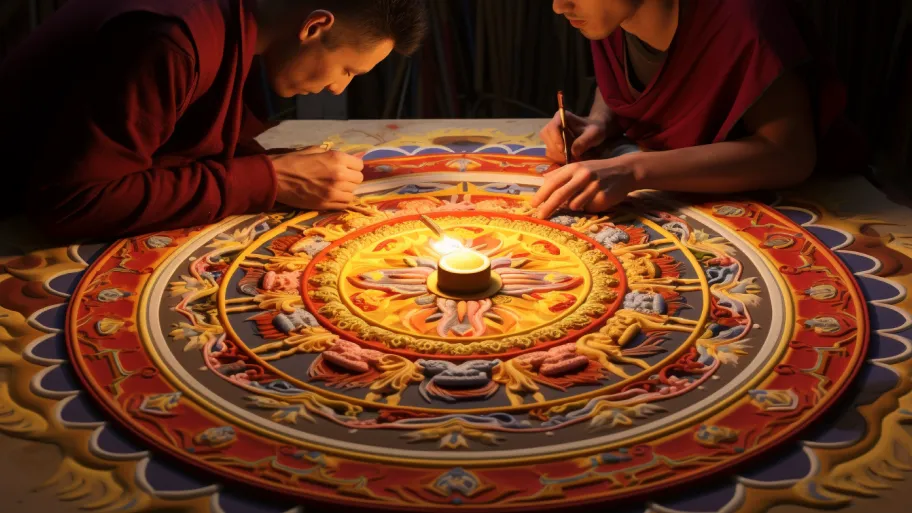
These use crushed-up pieces of colored stone or sand to create intricate designs.
The mandala is drawn on a flat surface, and the sand is then applied using a small funnel or tube.
This is created as a part of a Tibetan Buddhist ritual.
After the mandala is complete, it is destroyed by brushing it away with a broom. This symbolizes the ephemeral nature of reality.
2. The Healing Mandala

Healing mandalas help you to focus on the present moment and let go of negative thoughts and emotions.
They can be used as a form of self-care and can help you to feel more connected to your body and mind.
They help you to pay attention to the present moment and let go of unhelpful ideas and feelings.
They deliver wisdom, concentration, calm, and focus when you need it most.
3. The Teaching Mandala
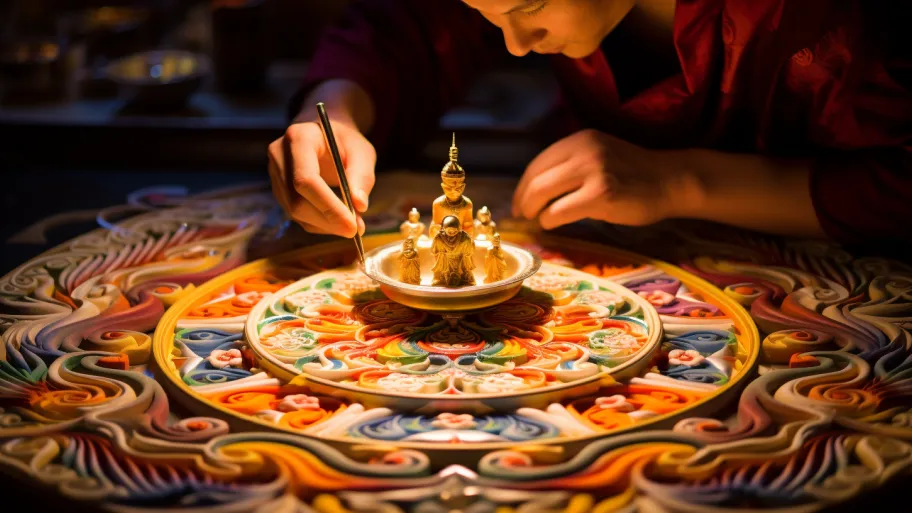
Teaching mandalas are artistic representations. Each form, line, and hue in a Buddhist teaching mandala represents various elements of the religion.
During the mandala-making process, monks contemplate the mandala’s meaning.
The mandala can be used as a tool for learning about the different aspects of Buddhism. It can also be used for concentration and meditation.
How to Create Your Own Mandala Art!

Designing and drawing mandalas can be a very creative and colorful process, and pattern design is an important part of the art form.
They can be created with a variety of mediums, but are typically drawn with a compass using pens, pencils, or markers.
How to Create Mandala Art
In this tutorial, we’ll be using the following materials. You’ll need these if you want to know how to draw a mandala with a compass:
- A piece of paper
- Pencil
- Colored pencils
- Eraser
- Ruler
- Compass
Top Tip: Use a pencil to draw the template for your mandala so that you can use an eraser later to remove the pencil marks once you have finished adding color to your mandala.
Here Are the Steps to Create Your Own Mandala Art:
Step 1: Practice Some Mandala Patterns
Before you start creating your mandala, it is important to practice mandala patterns and get familiar with them. Here we have included the picture of some most common patterns we have used when we create mandalas. Follow my patterns or create your own.

Now that you are familiar with mandala patterns it’s time to create your mandala!
Step 2: Mark the midpoints of the paper
First, find the midpoints of the paper WIDTH and HEIGHT
You can do this by measuring the WIDTH of the paper with the ruler.
- Place the ruler horizontally on the paper
- Mark a cross at the MIDPOINT (don’t forget to use a pencil, so you can use an eraser later)

- Then repeat the same process to find the HEIGHT of the paper.
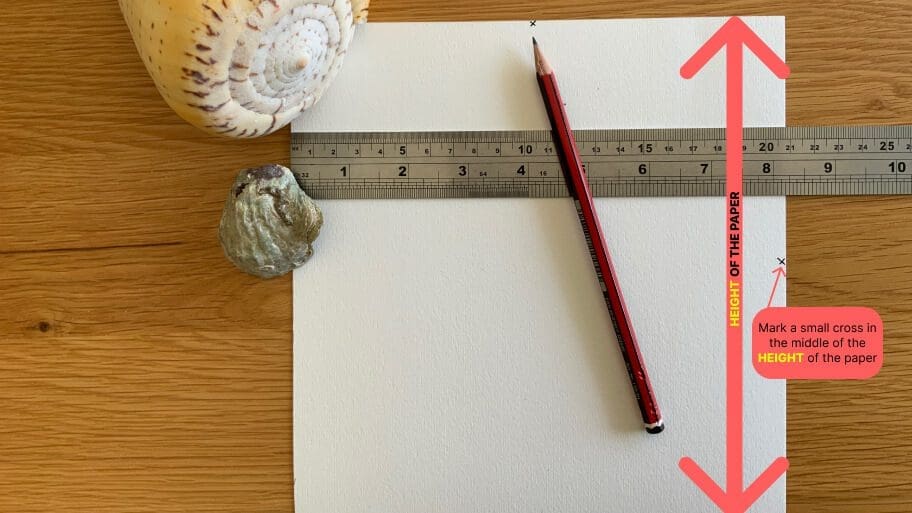
- Then mark all remaining sides so you have 4 crosses marked in total (one in the middle of each side of the paper).
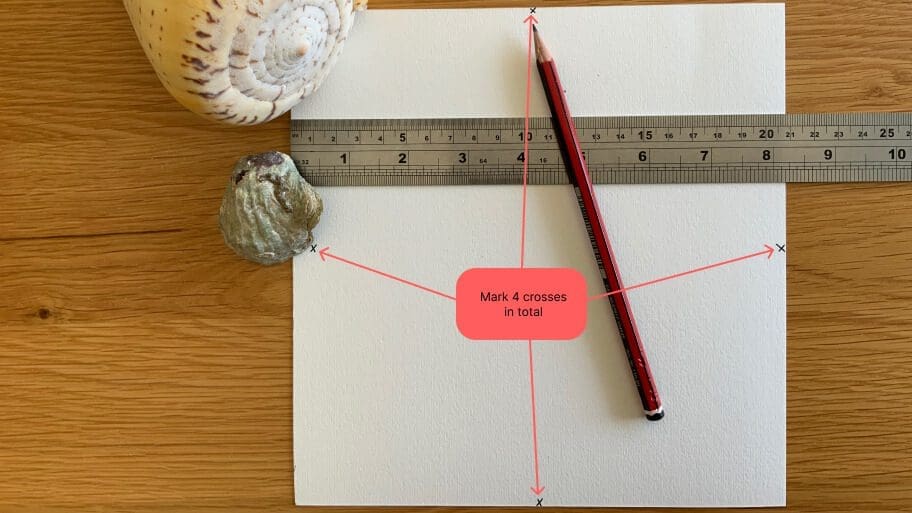
Step 3: Draw straight lines to connect the midpoints of the WIDTH and HEIGHT
- Draw a vertical line connecting the WIDTH midpoints
- Draw a horizontal line connecting the HEIGHT midpoints
- Mark a dot on the CENTER of the paper where the lines cross

Step 4: Draw a circle around the dot using a compass
- Place the compass needle on the dot in the center of the paper
- Set your compass width to the size of the mandala you want to draw and draw your main circle (we measured 8cm from the dot in the center, but it is up to you what size you want to use).
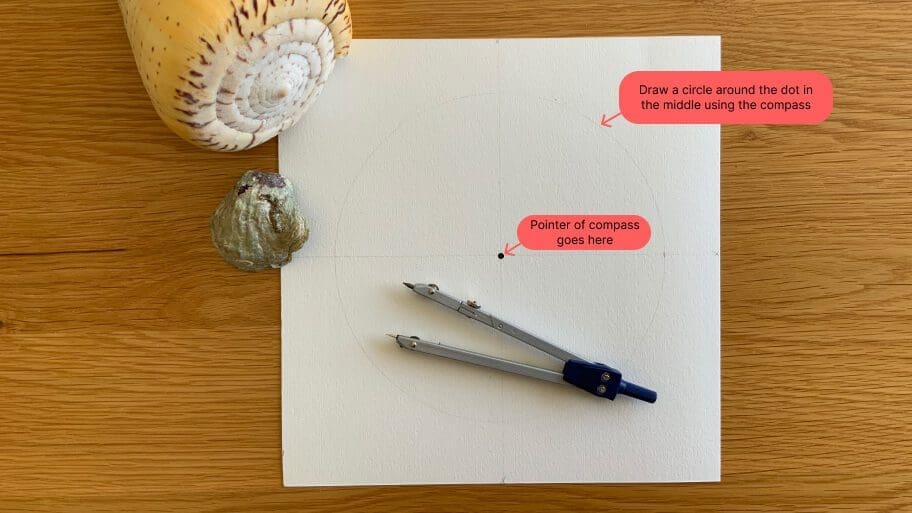
Step 5: Add as many circles as you want
- Repeat the circle drawing process from step 4 to draw smaller circles inside of your main circle (we kept our circles an equal distance apart by marking dots with the ruler 1cm apart from the dot in the center up to the edge of the main circle.

Step 6: Mark dots around your circle
- Use a protractor to mark dots in the circle with gaps of 10 degrees e.g., mark a dot at 10 degrees, then 20 degrees, then 30 degrees, etc., until you have marked dots in a full circle (360 degrees in total).
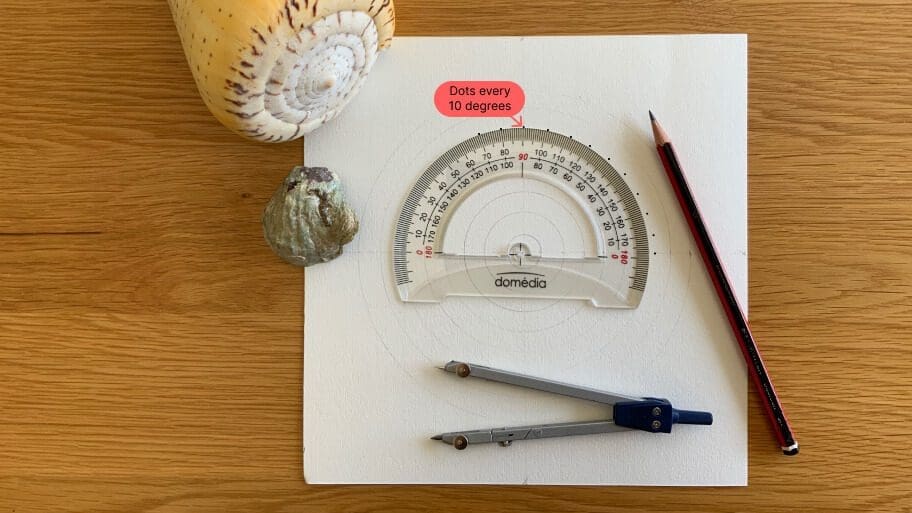
Step 7: Join opposite dots
- Draw lines to connect opposite dots (each line should split the circle into equal halves
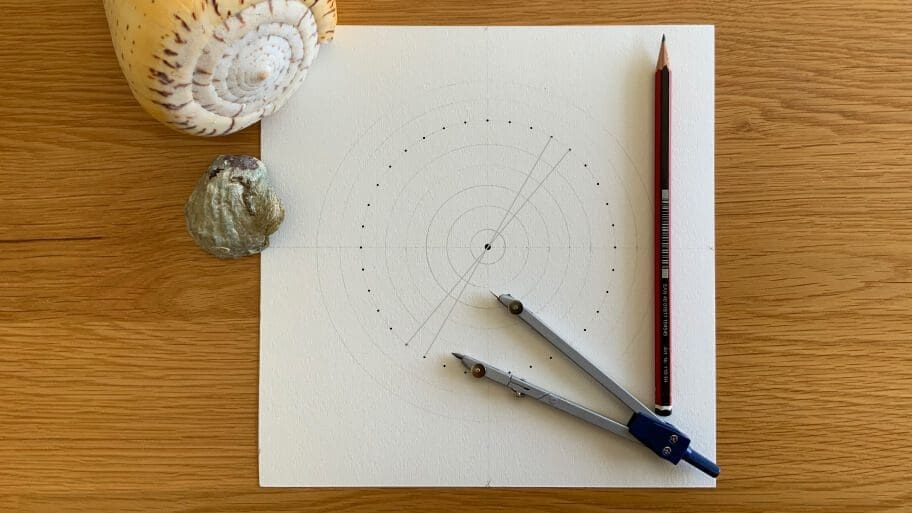
- Repeat the process until you join all of the dots.

Step 8: Add patterns to the circles
Remember the patterns you learned to draw in Step 1? Now it’s time to add those patterns to your mandala drawing!
- Add some cool mandala patterns to the inner circle

- Keep adding patterns until you fill the circle
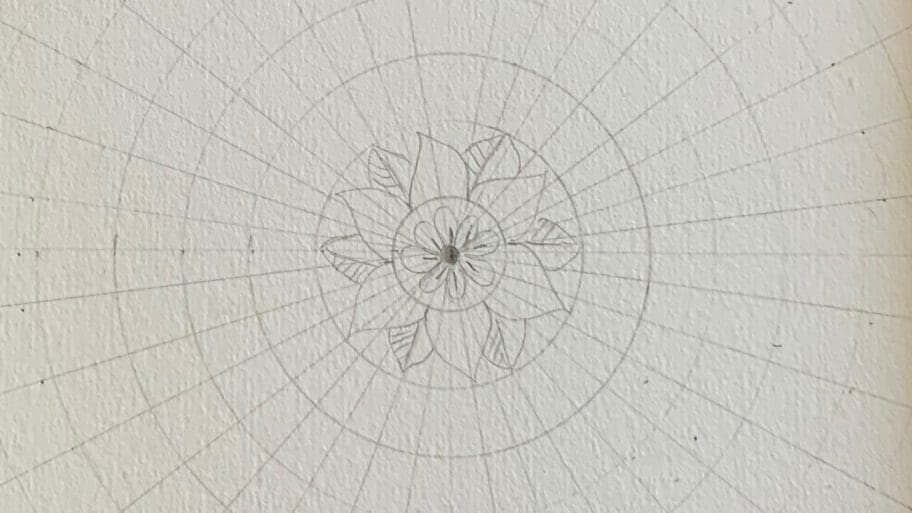
- Now repeat this process, adding patterns to each of the circles. Take your time and make sure your patterns and shapes are balanced on each side.

- Remember to use a light hand so you can easily erase your pencil after you have finished your mandala.
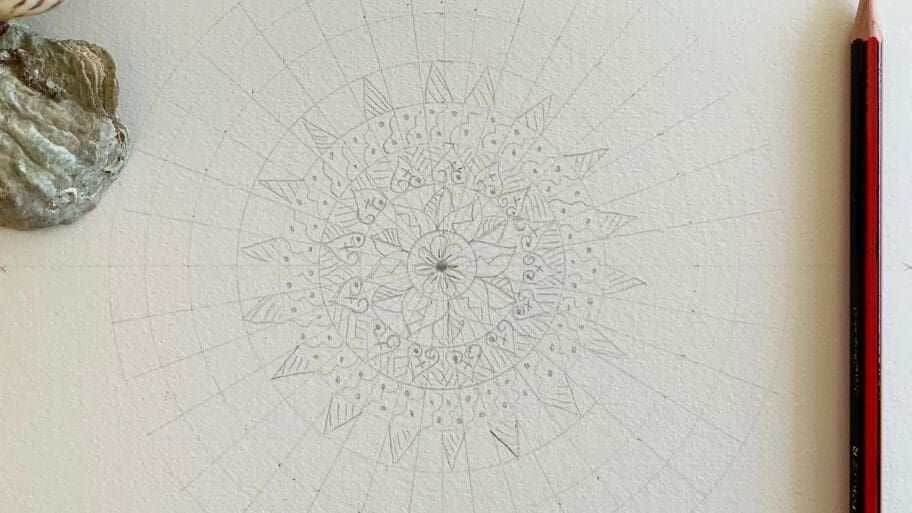
- Keep adding patterns until you have filled in all of the circles.

Step 9: Add color to your mandala
- Now fill each pattern and shape with your favorite colored pencils, markers or watercolors

Step 10: Remove pencil marks with an eraser
- Use your eraser to remove visible pencil marks
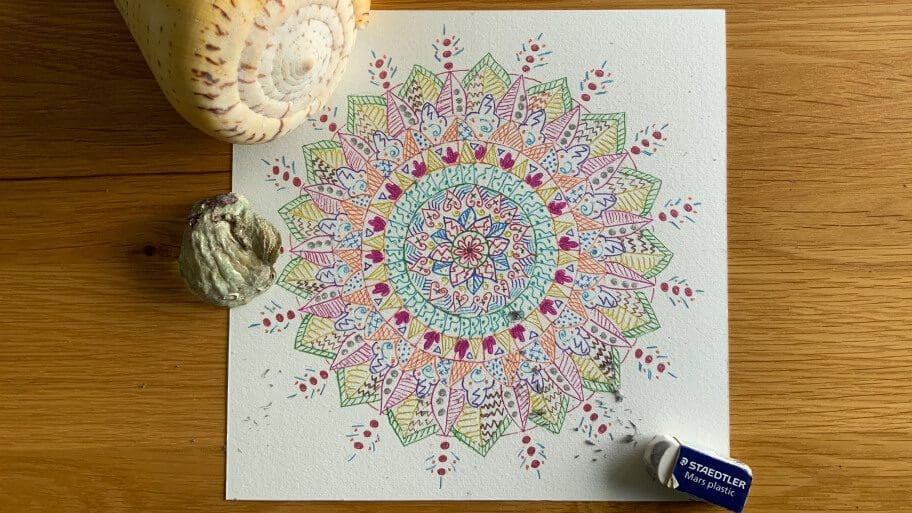
Congratulations! You just created your first mandala!
Keep practicing by changing your patterns or your medium. Get creative.
There you have it!
Now you know how to draw mandala step by step! This ancient art form is not only beautiful, but it can also be therapeutic and relaxing. So get out your pencils and paper and give mandala drawing a try!
Happy drawing 🙂
If you want to take your art to the next level, check out our selection of art guides below!
- A Guide to the Different Types of Digital Art
- 101+ Cool Easy Drawing Ideas to Explore Your Creativity and Improve Your Skills
- What are NFTs?
- 26 Types of Paint Brushes: Artists Guide
- 100+ Acrylic Painting Ideas: Plus Acrylic Painting Tools, Tips, and Techniques
- How to Sell Your Art Online
- Basic Patterns to Draw: A How-To Guide




